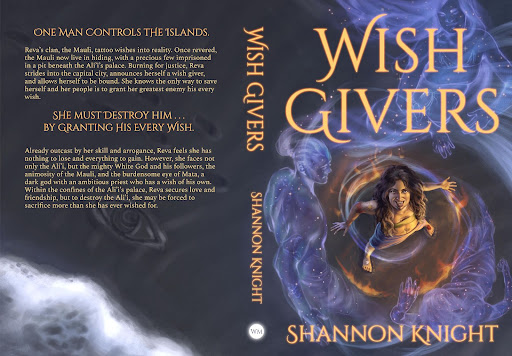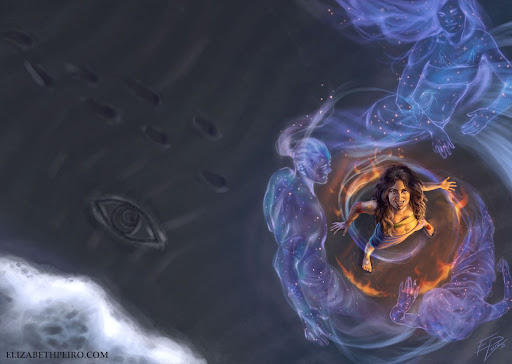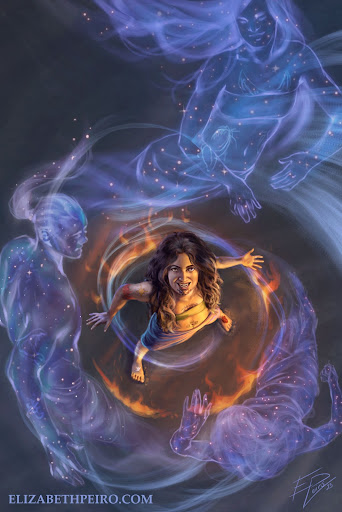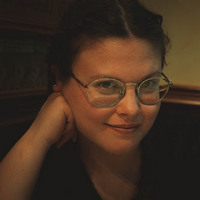After Shannon Knight sent in that great Guest Post about the cover of her book Grave Cold, she asked if I’d be interested in doing a Q&A with her and one of her cover artists. The next thing I knew, I was in the middle of a conversation (or whatever you call it when you’re all interacting on a Google Doc) with Shannon and Elizabeth Peiró.
We end up talking about being a cover artist, hiring and working with one, AI, and more—with an eye to the snazzy cover to Wish Givers, the cover that Eli provided for Shannon’s upcoming re-release.
I typically call these posts “A Few Quick Questions”—but we leave “Few” and “Quick” in the rearview mirror. So I’m going with “Some” (because that’s as creative as I am today).

Shannon’s introduced herself to my readers already, so Eli, why don’t you give my readers a quick introduction to you and your work—including whatever titles, websites, links, etc. you’re in the mood to share
Hello, everyone! My name is Elizabeth, but I go by Eli for short. I’m a freelance artist from Spain working for different sorts of clients, from publishing to card games, tabletop RPGs, and briefly video games. I would describe my work as realistic fantasy, as it is the genre I mostly gravitate towards, and the things I like to focus on are storytelling with bold colors and light. You can check out my portfolio on my web page, Elizabethpeiro.com, and on Instagram and Twitter as @Elizabethpeiro. All my contact info is easy to find in any of those places.
Eli, how does someone get into the freelance cover design business (obviously that’s vague, so speak of your own experience—but if you can comment on what others have done, feel free)? I don’t imagine you just hang your shingle out there (virtual or otherwise) and start getting clients.
Getting in, at least to the point where it is sustainable, economically speaking, is hard, I’m not going to lie. It is not only about the skill level in terms of technique or speed (which is quite important; the faster you are, the better pay per hour you get), but also building a client list that keeps you busy all year long. I’ve only been working full-time as a freelancer since 2021. Before that, I had a non-art-related part-time job. That gave me a stable income while I kept improving and working for both private clients and publishers. When I saw things were going pretty well with art, I gave it a try at working as an artist full time and took a year off. Luckily, I haven’t stopped since. In my personal case, some years ago I painted a fan art of Vin, the main character from Brandon Sanderson’s trilogy Mistborn. That caught the attention of some small publishers and authors because it was highly shared in the fantasy literature community. My following grew, and, with time, more people found my work through that piece (and some others). So, many of my clients have found me, not the other way around. Like a lot of things in life, it is about being in the right place at the right time. You can’t have control over that, but you can keep sharing your work and improving to be prepared when the opportunity happens. As a freelancer, having a social media presence is important, but the numbers are not everything; getting to the right people is. Using hashtags, knowing your potential clients, and promoting your work in their circles—like in some subreddits, where you can find a different audience who might need an artist and don’t know where to look for one, or pages to offer your services like Reedsy. There are illustration agencies, cold emailing to publishers… Looking for work is a job in itself! There is a lot of rejection and ghosting, so you have to build a tough skin, but clients eventually show up if you are persistent.
Shannon, how did you set out to find an artist, and how did you come across Eli? Can you remember what it was about her work that made you interested?
I admired and followed Eli’s art long before I was in a position to choose my own cover artist. As a lifestyle choice, I enjoy following artists on social media.
In search of cover artists, I ramped up my art searches on Twitter. Artists share their own work and each others’ work there a lot, so it’s easy to dive into a lot of genre artwork.
Maybe years ago–I don’t remember when–the first work I saw by Eli was a piece called Strength of Ten, which depicts a woman hauling a Viking ship through ice and snow. I love so much about that painting: the colors, the lighting, the angles, the storytelling, the expression. Women in fantasy art have a long history of being depicted as sex objects. The woman in this painting is powerful and distinctive. She’s performing an amazing feat, straining her body. So many choices in this painting are commercially brave and interesting to me. I’ve watched Eli as an artist ever since I first saw that painting. [I just went to check out Strength of Ten, I can absolutely see why that would grab your attention]
For my Wish Givers cover, I needed an artist who painted skin tones that were not just white people. I’ve noticed many artists have a limited number of body types or skin tones they work with. Eli’s portfolio showed her skill there. I also wanted color, such as two different light sources with different colors, and Eli does that so well. Finally, I wanted a bold expression on my protagonist’s face rather than a neutral one. I know that’s hard, but once again, Eli’s portfolio proves her skills there.
The next step was to check her interest, availability, and prices to learn if we might be able to work together.
Eli, do you have any advice for those looking for an artist that Shannon didn’t mention? Obviously, the short answer is hiring you. But let’s pretend you can’t take on a client, what should they do?
Each project has different needs, and because of all the reasons Shannon listed, I was the right fit for her cover. She already knew what she wanted when she contacted me, so my advice to anyone who’s looking for an artist is to spend time thinking about what it is that they need their cover to convey, what style fits their story, and what will catch their audience’s attention the most. It’s not about your knowledge of art; you are hiring someone who’s a professional, who will bring your ideas to life, and who will help you make up your mind about what route you could take. But before any of that can happen, you need to be sure you are contacting someone who can do the kind of work you need. Also, having an idea of the timeframe and budget you have is ideal when you start your search. As for WHERE to start looking, places like ArtStation, Twitter, Instagram (well, any social media – Tumblr, LinkedIn, Reedsy…) or through hashtags- #Portfolioday, #Visiblewomen #DrawingWhileBlack… also Mari Naomi’s databases for POC, Queer or Disabled artists (to name one, there must be more out there). Those are also great places to find not only someone with the style you are looking for, but also people with sensibilities or knowledge about what you want.
Shannon, you’ve talked before to me about “standard fantasy cover expectations” and YA characteristics. how do you describe that kind of thing to Eli (or anyone) to make sure you’re on the same page?
You know, that’s an interesting question, H.C. It never even occurred to me to explain that to my cover artists. I assumed they would be even more deeply aware of conventions than I am. Also, I chose artists whose usual style matches the conventions I’m seeking.
Regarding expectations with Eli, I included a long description of what I had in mind for the cover, accompanied by reference images for each component. At the end of all that, I gave her a numbered list of my priorities for the artwork. Let me dig through my emails. Here it is:
My cover image priorities:
1) eye-catching image that makes a prospective reader stop and look
2) immediately identifiable as adult fantasy fiction
3) dark fantasy mood
4) Polynesian looking character
5) your specialties: color, light, character expression
Eli, any follow-ups to that? Any additional advice?
It’s pretty much what I said in the previous question: know what you want and analyze if that artist’s portfolio shows what you need.
Communication is so important from the beginning; artists know how to handle clients, how to turn ideas into images, and we know what we are doing. But for the process to be smooth, both parties need to be on the same page. If you are not sure about something, just ask (either if you are the artist or the client).
Shannon made her points very clear. She even had the references and made a rough sketch of her idea (which is not a must, but the more you provide to help the artist understand what you need, the better). On my side, I always want to be transparent from the beginning about the way I work, the process (I shared with Shannon the process of other cover pieces I’d done in the past), my schedule (because I work on various projects at the same time).
When pitching ideas, do you literally show existing covers by others and say “like this one, but without X” or “something that feels like/has the same vibe as this”? Or do you leave other peoples’ work out of the conversation?
Shannon: For Wish Givers, my cover design depended on the artist. When I considered different artists, I was considering different cover designs that matched their special skills. For Eli, I also had the mistaken expectation that I needed to arrive with a design, which I sketched (poorly) and accompanied with clarifying photos for each of the design elements.
Eli has been out-of-this-world from day one. She has continually offered and done more than I’ve expected on every level. Regarding design, she accepted my design and returned it to me in her style along with two other designs that matched the scene described. I got to look at three sketches by Eli and choose between them.
However, I do have a link to what you were asking about. The cover of Wish Givers includes ghosts. I didn’t know how to best handle them. When I was describing my ideas and possibilities, I included some existing paintings. One was a book cover from the 90s by Keith Parkinson for The Scions of Shannara [I remember that cover from when it came out in High School]. It has a stream of ghostly figures. Another was an ancestor painting by a Hawaiian artist called LeoHone with ghosts alongside their descendants. She’s painted a whole series of these, which are really cool–check them out! I also included a photo of an actor playing Maui standing in a dense mist. I wanted Eli to understand that I really didn’t have a set image in mind for how to handle this aspect of the painting, but I also felt I should share my general ideas. Then she could take it from there.
Eli: I always offer at least two options, even if, like in this case, Shannon already had a strong idea of what she wanted. It is a good way to see if that’s really the way to go, or to refine that initial concept with bits from the others. Each client and project is different; sometimes you have a lot of freedom, and sometimes there’s not so much room to explore. Neither is good nor bad, but it is always a team effort.
Shannon has talked about the ghosts, and they were the tricky point. The cover had to say “fantasy,” not “horror”. The character was the center point, but there were these big, human-size shapes above her, surrounding her, taking up a lot of space. So it was really challenging to make it all work out, and I thank Shannon for her patience with all the changes I made to them.
Something to have in mind as an artist as well is to keep it all under budget; that’s why the ghosts are more similar to The Scions of Shannara cover than to the LeoHone ones. Keeping them simple makes the cover work equally well (and even helps to keep the focus on Reva, the main character), and the price stays within her budget.
Shannon: Yes, when I shared the example paintings with Eli, I mentioned that as beautiful as the LeoHone style was, I didn’t think it would be within my budget for Eli to paint the cover in that style. I really appreciate being able to be transparent with ideas and also with my price range so that we could find a style that fit both.
Eli: As a professional, I find it important to be transparent about all that stuff, explain everything well, and try to find a middle ground that works for both me and the client.

Eli, are there genres that you won’t do/don’t think you can do at this stage of your career? Or are you at an “I’ll do anything” stage? Are there genres that you haven’t done a cover for that you’d like to try?
More than the genre, it is the subject that would make me say no to a project. For example, I’m not known for painting sci-fi, but last year I painted a few illustrations of the genre, and I really enjoyed them! But if you make me paint a cover where the only element is a starship, I would say no. There are plenty of people who would do a way better job than me, and I simply wouldn’t enjoy it. The same would happen if someone asked me to paint a fantasy illustration but with a really complicated composition and lots of characters. It is not my forte, so I should have all the details about what they need and think about whether it is something that I can really pull off. I’m lucky to be in a position in my career where I can choose (to an extent), and people usually approach me to paint things similar to what I show in my portfolio.
As for interesting projects, maybe something horror-related or with a pulp novel vibe would be fun to work on. But as I said, it is usually a matter of having an interesting concept to work with that fits my skills.
That makes a whole lot of sense–I’m used to thinking in terms of genre when talking to writers/readers or just thinking about books. But when it comes to great cover art, who cares about the genre of the book?
Are there examples of cover art/design recently that have made you stop and say, “I’d love to try something like that one day”
Shannon: I see all sorts of captivating covers. So many artists are doing amazing work. There are covers in styles I’ve long favored, and there are covers I see in new, distinctive styles that catch my eye. But mostly, my mind is on prospective stories rather than prospective covers.
I’ll do some name-dropping, though. Eleonor Piteir is a Portuguese artist I also considered for Wish Givers. Her style is really interesting. Carissa Susilo is a Canadian artist whose mixed media work is gorgeous.
Eli: I know Eleonor and she’s an amazing artist (and a great person too!). I love her style; it is one of those that makes me want to experiment and get out of my comfort zone. Carissa’s work is also really beautiful and inspiring to me.
There is beauty in variety, and I don’t prefer one style over another. (Well, I’ll be honest, I’m not a fan of big publishers doing those covers with a small stock photo on one side and a Helvetica Bold title on the other. Give me something! Haha!) 8-D
Shannon and HC: Haha!
Eli: Different stories and audiences connect better with certain things, and as an artist, I find inspiration everywhere.
Shannon: Yes, that’s true!
Eli: When reading the question, a cover that came to mind was the one for the illustrated edition of The Last Wish, the first book of the Geralt of Rivia saga, published by Tor Books. It is by Tommy Arnold, and the bold, red color in the background in contrast with the silhouette of the character, the dark and limited values… It is a mesmerizing piece, not only because I find it eye-catching, but also because it is magnificent from a technical perspective as well. [Assuming I just linked to the correct cover, that is an awesome cover, and I could spend too much time on Arnold’s website]
Shannon: Oh, Tommy Arnold! I loved his covers for Gideon the Ninth and Harrow the Ninth by Tamsyn Muir!
Eli: Same! He’s one of those artists who always end up in my reference boards.
Eli, could you walk us through the typical process (assuming there is one) of designing a cover? I wanted to break this down part by part, but I don’t think I know enough to try that. So I’m going to go with a broad question.
Things start with the typical approach of “I need an artist, here is what I want, are you interested?”
Ideally, the first contact email should contain enough information for me to be able to decide with that one email if I’m able to say yes or no. The main points are:
• Timeframe
• Budget
• Format/s (only front cover, full wrap, printed, e-book, etc.)
• Concept and elements of the cover
After the negotiation point and signing the contract, I usually ask for as many references as they can provide me, either quick sketches they can make, photos, other artworks, excerpts of the story… The more, the better. That way, I can make sure I understand their vision.
Then I would proceed to start drawing and send the sketches. Here, it varies from project to project, but I make at least a couple of sketches—sometimes black and white, sometimes in color, and once they pick one, I offer different color and light schemes. For Wish Givers, I sent Shannon three ideas in color, as the background and lighting were already discussed at the beginning.
Once one of them is approved, I start rendering. When things are taking shape, I send a WIP to the client to make sure I’m on the right track and apply changes if necessary. This can happen once, twice… It varies. The changes within the original budget are minor adjustments, if something major is needed, there’s an extra fee depending on the complexity. But that wasn’t the case here.
Once I find the work is done, I show it to the client, they approve it, and I send the final files.
For the payment, I usually ask for at least half in advance, that way, I make sure people won’t disappear halfway. But I’ve always had good experiences with clients and never had trouble with that.
Eli, obviously, the hot-button topic of the moment is the use of AI in art. For you, is it a blanket “no AI at all in my material”? Or is there a place for some limited use of it? How would you describe that use?
It is a complex topic because there are different kinds of AI and different uses for them.
One example of a good use is from the Into the Spider-verse film. It’s not my area of expertise, and I won’t use the right wording for sure, so here is a clip showing it: https://youtube.com/shorts/bskSiIdtjr0?feature=share
This helps artists with tedious work, and it is “trained” with material from the studio, not to steal but as a tool. That’s the point: for it to be a TOOL.
The kind of AI we are encountering on the internet that is gaining more and more notoriety is the “bad” one. The one that’s non-consensually trained with every dataset they find on the internet, and it is used as a way to create quick images (or texts, or whatever). Our society, our culture, is nourished by human experiences. This is how we evolve, in some ways. Literature, art, entertainment, etc. are mirrors and products of the time and place in which they are produced. If we let every mainstream piece of art be a regurgitated mix of already existing and stolen ideas, what value are we giving to our culture?
And besides all the jobs that will be potentially lost to this unless there’s regulation, there are so many terrible applications for that. Now, AI-generated images are (usually) easy to spot. But it is only a matter of time before it becomes hyper-photorealistic. Using people’s likeness to create fake photos, fake news supported by AI-generated images…
I don’t want to sound dramatic with all of this, but it is starting, and there should be laws regarding its use and how it is trained before it is too late.
I really appreciate the emphasis on AI as a tool. That’s the difference, really, isn’t it? Using it to aid and assist the human creative vs. using it instead of the human.
Shannon, do you have any follow-up thoughts on your side? Would you consider any kind of AI art on your books?
Generative AI is built on the theft of other people’s work, which is then reassembled according to the most common denominator. Consider all of the sentences used in a story inputted and selected based on which word combinations are most expected to be seen. Even with the magical thinking that systems built on theft would suddenly only contain work that has been ethically, in some dream manner, sifted through–that’s not quality. That’s not what art is about at all. I find it absolutely abhorrent on every level. Why would I ever want to produce something built of the averages of other people’s stolen work? I want no part of it.
Some writers have talked about using AI that has only been trained on their own work–a bit like the animation example Eli was sharing. But for writing, I don’t like that either. Each time I write, I aim to create something new. I also feel like I AM new. I’m not who I used to be–that’s how life works. Each story I write is made of something new that comes from inside of me.
Eli, there’s been a big backlash to AI art recently—but we know it’s already been used. After the initial fervor dies down, do you think AI is going to become an accepted element of covers? Are the ‘bots going to come along and take your job?
We live in a world where we are “disposable” as workers. The bigger the benefit, the better. I know there will always be people like Shannon, who appreciate human-made art. And I haven’t asked every person I know, but I highly doubt any of my acquaintances want to read or watch things written by an AI.
I want to think otherwise and not sound (or think) too depressing. I hope this is only a phase, and we will reach a point where this will be forgotten and used in ways that will really help people, such as applications outside of writing or painting.
Come to think of it, Shannon, that’s a fair question for you, too.
Generative AI is not the replacement for human creatives that some people imagine it to be. Capitalism presents the cheapest option of anything as the best. Misinformation, theft, and mediocrity are fine for capitalism. Biases are fed into the system and outputted even larger with the mind game that automation could only produce neutral content, so racism, sexism, etc. all get faux stamps of approval, and the status quo, with wealthy white guys on top, is further promoted. However, we are experiencing a major workers’ rights movement across many industries. It’s not a coincidence that these events are happening alongside a continuing pandemic and rising climate crisis. People are being crunched from all sides, with minorities and the poor facing the worst of it. All of us need to choose to take a stand together to protect each other and allow people to live in dignity. The alternative is not just a financial crisis and a rise in homelessness, but a deficit for all of us in the art that continues to be produced. Generative AI penalizes creatives in such a way that many fewer would commit to continuing to create in this hostile environment. Young people will be advised against building their skills and pursuing artistic careers. It’s not really a matter of replacing us. Generative AI as it currently stands does not even touch our skill levels. But already many writing and editing jobs are being presented as fixing the slop created by AI, paying hourly rates lower than those offered to work at my favorite grocery store. Corporations are refusing conservative pay raises for existing staff while offering hefty wages to AI specialists; these businesses would rather invest in problematic, experimental technology than their existing workforce. Meanwhile, students are submitting AI-generated homework. Why bother to learn how to think or write when discernment and critical thinking are not valued? Let’s not teach children that plagiarism is the path to the future. Undervaluing each other so that we can climb up each other’s backs is not the future we want. Pandora’s Box has been opened. Unless wide-ranging legal action is taken to inhibit generative AI, it will continue to be a criminal obstacle that artists must navigate so that wealthy tech bros can get richer off of stolen labor.
Eli: Shannon made excellent points here, I don’t think I have anything else to add. This is bigger than just “a computer making an image” or “writing a text”.
Absolutely. I think you two nailed it here…I’ve got nothing to add.
Thank you both so much for this. Hopefully, the readers like this as much as I did!

Elizabeth Peiró:
 Mi nombre es Elizabeth Peiró, Eli para acortar, y soy una artista especializada en fantasía de Barcelona, España. Mis obras tienen como sujeto central los personajes y la narrative.
Mi nombre es Elizabeth Peiró, Eli para acortar, y soy una artista especializada en fantasía de Barcelona, España. Mis obras tienen como sujeto central los personajes y la narrative.
La mayor parte de mi aprendizaje ha sido de manera autodidacta, con libros o múltiples blogs, videos y recursos varios disponibles en internet, además de haber realizado una mentoría con el artista Donato Giancola. Tras ella me empecé a dedicar al arte a tiempo completo, trabajando mayormente para juegos de rol, cartas y el sector editorial, colaborando tanto con autores autoeditados, como Shannon Knight, como con grandes editoriales como Macmillan Publishers.
(in English) My name is Elizabeth Peiró, Eli for short, and I’m a fantasy artist from Barcelona, Spain. The main subjects in my work are characters with a focus on narrative.
Most of my learning process has been self-taught, through reading books, blogs, videos, and multiple resources I found on the Internet, on top of attending a mentorship with artist Donato Giancola, after which I started my full-time career as an illustrator. I’ve been working mostly for ttrpg, card games, and publishing, with clients such as self-published authors, like Shannon Knight, or bigger publishers, like Macmillan Publishers.
Shannon Knight:
 Shannon Knight lives in the Pacific Northwest with her faithful feline, the best cat on this planet. Their adventurous lives include coffee, reading, ribbon games, and K-dramas. Prior to settling in the PNW, Shannon traveled to islands, living briefly on some and sailing from Java to Christmas Island on a small ketch. Much later, Shannon fell ill with the novel COVID-19 virus and became primarily bedbound for about two and a half years. The first thing she did upon regaining the ability to sit up all day was complete the publication of Wish Givers, Insiders, and Grave Cold.
Shannon Knight lives in the Pacific Northwest with her faithful feline, the best cat on this planet. Their adventurous lives include coffee, reading, ribbon games, and K-dramas. Prior to settling in the PNW, Shannon traveled to islands, living briefly on some and sailing from Java to Christmas Island on a small ketch. Much later, Shannon fell ill with the novel COVID-19 virus and became primarily bedbound for about two and a half years. The first thing she did upon regaining the ability to sit up all day was complete the publication of Wish Givers, Insiders, and Grave Cold.
Wish Givers can be purchased here.


